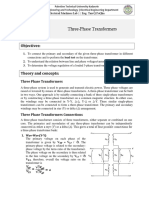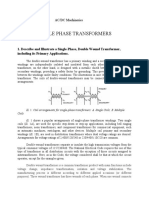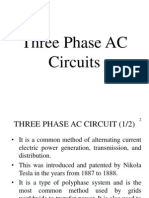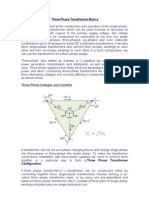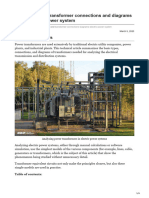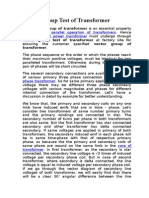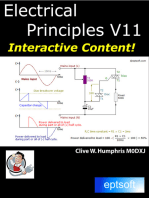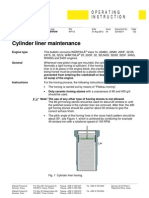Transformers
Transformers
Uploaded by
Moawiah Al-HawajrehCopyright:
Available Formats
Transformers
Transformers
Uploaded by
Moawiah Al-HawajrehOriginal Description:
Original Title
Copyright
Available Formats
Share this document
Did you find this document useful?
Is this content inappropriate?
Copyright:
Available Formats
Transformers
Transformers
Uploaded by
Moawiah Al-HawajrehCopyright:
Available Formats
THREE-PHASE TRANSFORMERS
Transformers for three-phase circuits can be constructed in one of two ways:
- three single-phase transformers connected in a three-phase bank.
- three sets of windings wrapped on a common core, as below.
A single three-phase transformer is lighter, smaller, cheaper, and slightly more
efficient, but using three separate single-phase transformers has the advantage that
each unit in the bank could be replaced individually in the event of trouble. A utility
would only need to stock a single spare single-phase transformer to back up all three
phases, potentially saving money.
Three-Phase Transformer Connections
The primaries and secondaries of any three-phase transformer can be independently
connected in either a Wye (Y) or a delta ( ). This gives a total of four possible
connections for a three-phase transformer bank:
1) Wye- wye (Y - Y)
2) Wye-delta (Y - )
3) Delta-wye ( -Y)
4) Delta-delta ( - )
The impedance, voltage regulation, efficiency, and similar calculations for three-
phase transformers are done on a per-phase basis.
WYE-WYE CONNECTION
This connection is shown below.
Yasin A. Al Shiboul, Al Balqa Applied University, Faculty of Engineering Technology, EE Department
In this connection, the primary voltage on each phase of the transformer is given by
V
VP LP . The primary-phase voltage is related to the secondary-phase voltage by
3
the turns ratio of the transformer. The phase voltage on the secondary is then related
to the line voltage on the secondary by VLS 3VS . Therefore, overall the voltage
ratio on the transformer is:
V LP 3VP
a
V LS 3VS
The Y-Y connection has two very serious problems:
1) If loads on the transformer circuit are unbalanced, then the voltages on the phases
of the transformer can become severely unbalanced.
2) Third-harmonic voltages can be large.
Notice thet if a three-phase set of voltages is applied to the Y-Y transformer, the
voltages in any phase will be 120 0 apart from the voltages in any other phase.
However, the third-harmonic components of each of the three phase voltage will be in
phase with each other, since there are three cycles in the third harmonic for each cycle
of the fundamental frequency. There are always some third-harmonic components in
transformer voltage because of the nonlinearity of the core, and these components add
up. The result is a very large third-harmonic component of voltage on top of the
fundamental voltage. This third-harmonic voltage can be larger than the fundamental
voltage itself.
Both the unbalance problem and the third-harmonic problem can be solved using one
of two techniques:
1) Solidly ground the neutrals of the transformers, especially the primary winding's
neutral. This connection permits the additive third-harmonic components to cause a
current flow in the neutral instead of building up large voltages. The neutral also
provides a return path for any current imbalances in the load.
2) Add a third (tertiary) winding connected in to the transformer bank. If a third
-connected winding is added to the transformer then the third-harmonic
components of voltage in the will add up, causing a circulating current flow within
the winding. This suppresses the third-harmonic components of voltage in the same
manner as grounding the transformer neutrals.
The -connected tertiary windings need not even be brought out of the transformer
case, but they often are used to supply lights and auxiliary power within the substation
where it is located. The tertiary windings must be large enough to handle the
circulating currents, so they are usually made about one-third the power rating of the
two main windings.
One or the other of these correction techniques must be used any time a Y-Y
transformer is installed. In practice, very few Y - Y transformers are used, since the
same jobs can be done by one of the other types of three-phase transformers.
WYE-DELTA CONNECTION
This connection is shown in the following figure.
Yasin A. Al Shiboul, Al Balqa Applied University, Faculty of Engineering Technology, EE Department
In this connection, the primary line voltage is related to the primary phase voltage by
VLP 3VP , while the secondary line voltage is equal to the secondary phase voltage
VLS VS . The voltage ratio of each phase is:
VP
a
VS
The relationship between the line voltage on the primary side of the bank and the line
voltage on the secondary side of the bank is:
VLP 3VP
3a
VLS VS
Notice that this connection has no problem with the third-harmonic components in its
voltages, since they are consumed in a circulating current on the side. This
connection is also more stable with respect to unbalanced loads, since the partially
redistributes any imbalance that occurs.
This arrangement does have one problem, though. Because of the connection, the
secondary voltage is shifted 30° relative to the primary voltage of the transformer.
The fact that a phase shift has occurred can cause problems in paralleling the
secondaries of two transformer banks together. The phase angles of transformer
secondaries must be equal if they are to be paralleled, which means that attention
must be paid to the direction of the 30° phase shift occuring in each transformer bank
to be paralleled together.
Notice that, the connection shown in the previous figure will cause the secondary
voltage to be lagging if the system phase sequence is abc (positive sequence). If the
system phase sequence is acb (negative sequence), then the secondary voltage will be
leading the primary voltage by 30°.
DELTA- WYE CONNECTION
This connection is shown in the following figure.
Yasin A. Al Shiboul, Al Balqa Applied University, Faculty of Engineering Technology, EE Department
In this connection, the primary line voltage is equal to the primary-phase voltage
V LP VP , while the secondary voltages are related by VLS 3VS . Therefore, the
line-to-line voltage ratio of this transformer connection is:
VLP VP 1 VP a
VLS 3VS 3 VS 3
This connection has the same advantages and the same phase shift as the Y-
transformer. The connection shown in the previous figure makes the secondary
voltage lag the primary voltage by 30 0 , as before.
DELTA-DELTA CONNECTION.
This connection is shown in the figure below.
In this connection:
V LP VP and V LS VS , thus:
Yasin A. Al Shiboul, Al Balqa Applied University, Faculty of Engineering Technology, EE Department
V LP VP
a
V LS VS
This transformer connection has no phase shift associated with it and no problems with
unbalanced loads or harmonics.
Yasin A. Al Shiboul, Al Balqa Applied University, Faculty of Engineering Technology, EE Department
You might also like
- Ybus Matrix With Regulating Transformer - Self Study TopicDocument21 pagesYbus Matrix With Regulating Transformer - Self Study TopicSankar MuthuswamyNo ratings yet
- Universal Design in HousingDocument22 pagesUniversal Design in HousingDewita SoeharjonoNo ratings yet
- Three-Phase TransfomersDocument10 pagesThree-Phase TransfomersAhmad AbunassarNo ratings yet
- Three Phase TransformersDocument11 pagesThree Phase TransformersNosta SilvaNo ratings yet
- Lecture Slide On Three-Phase TransformersDocument13 pagesLecture Slide On Three-Phase TransformersMubarrat Hossain SaminNo ratings yet
- Three-Phase Transformers: ExperimentDocument8 pagesThree-Phase Transformers: ExperimentKoti ReddyNo ratings yet
- Lecture 4-The Autotransformer 3phase 1Document34 pagesLecture 4-The Autotransformer 3phase 1MasterArvinNo ratings yet
- Three Phase Transformers PDFDocument53 pagesThree Phase Transformers PDFSanya0% (1)
- 1. 3Φ TransformersDocument220 pages1. 3Φ TransformersKyambi MutiaNo ratings yet
- Star Delta TrafoDocument6 pagesStar Delta TrafoAries ApriheriantoNo ratings yet
- EEC236 - Lecture 3-Three Phase TransformersDocument14 pagesEEC236 - Lecture 3-Three Phase TransformersLord bismarkNo ratings yet
- EM_2_3_4_mergedDocument13 pagesEM_2_3_4_mergedagarwalanshumaanNo ratings yet
- Three-Phase To Two-Phase/One-Phase Conversion Using TWO TRANSFORMERS (Scott Connection)Document13 pagesThree-Phase To Two-Phase/One-Phase Conversion Using TWO TRANSFORMERS (Scott Connection)Bhavani Chandra UniqueNo ratings yet
- Modul 10 Mesin Listrik 1 PDFDocument13 pagesModul 10 Mesin Listrik 1 PDFaswardiNo ratings yet
- Vincoy Assignmen 8Document18 pagesVincoy Assignmen 8Vincoy JohnlloydNo ratings yet
- Wye-Wye Transformers & Tertiary WindingsDocument5 pagesWye-Wye Transformers & Tertiary Windingssasahito100% (1)
- Power System AnalysisDocument40 pagesPower System AnalysisAkhtarNo ratings yet
- DELTA-DeLTA Connection of A Three Phase TransformerDocument14 pagesDELTA-DeLTA Connection of A Three Phase TransformerDevee AmbasNo ratings yet
- Vincoy, John Lloyd Single Phase TransformerDocument19 pagesVincoy, John Lloyd Single Phase TransformerVincoy JohnlloydNo ratings yet
- Three Phase Ac CircuitDocument38 pagesThree Phase Ac CircuitRuby Vega100% (1)
- LAB 06 To Make The Three Phase Transformer Connections ( - Y, - , Y-, Y-Y) and Verify The Line and Phase Voltages and CurrentsDocument5 pagesLAB 06 To Make The Three Phase Transformer Connections ( - Y, - , Y-, Y-Y) and Verify The Line and Phase Voltages and CurrentsMuhammad MashamNo ratings yet
- P1 c5Document38 pagesP1 c5muaz_aminu1422No ratings yet
- Lab Report: Experiment-3Document6 pagesLab Report: Experiment-3ayash mohantyNo ratings yet
- Zero Sequence ImpedanceDocument11 pagesZero Sequence ImpedanceBharat100% (1)
- CHPT 4Document54 pagesCHPT 4Yahya Faiez Waqqad0% (1)
- PS2 Report2Document6 pagesPS2 Report2Khan Islam MaheNo ratings yet
- Experiment No 5Document7 pagesExperiment No 5Sana ChaudryNo ratings yet
- Definition of TransformerDocument9 pagesDefinition of TransformerBaquiran John Paul BaquiranNo ratings yet
- Abdul Wahab LAB 6 EMDocument8 pagesAbdul Wahab LAB 6 EMFahad AliNo ratings yet
- Open Ended LabDocument6 pagesOpen Ended LabJourney With MeNo ratings yet
- A Design Guide For HV Transformer Connection SelectionsDocument6 pagesA Design Guide For HV Transformer Connection SelectionsShiv ChauhanNo ratings yet
- Three Phase Transformer FullDocument26 pagesThree Phase Transformer FullPKNo ratings yet
- NOTES Mod6Document16 pagesNOTES Mod6eeetistNo ratings yet
- Tsaadiquu PDFDocument31 pagesTsaadiquu PDFtadepeace23No ratings yet
- DeltaDocument6 pagesDeltaCharles RobiansyahNo ratings yet
- Paralleloperationoftransformer 200326231126Document13 pagesParalleloperationoftransformer 200326231126bhoirnilay2No ratings yet
- Relay Setting (Directional) : Leakage FluxDocument8 pagesRelay Setting (Directional) : Leakage Fluxjyoti kachareNo ratings yet
- TOPIC-11-THREE-PHASE-TRANSFORMERDocument26 pagesTOPIC-11-THREE-PHASE-TRANSFORMERSatoru FujinumaNo ratings yet
- Exp5. VTDocument10 pagesExp5. VTMohammed Abu Al HaijaNo ratings yet
- Lecture 2, Per Unit System, November 2022Document100 pagesLecture 2, Per Unit System, November 2022Igombe IsaacNo ratings yet
- Disc WindingDocument14 pagesDisc WindingMostafa ElngarNo ratings yet
- Topic 11 Single Phase Transformer y Delta Conn.Document25 pagesTopic 11 Single Phase Transformer y Delta Conn.ANTHONETTE BERNABENo ratings yet
- Negative-Sequence Relay Protection For Blown High-Side Transformer Fuse DetectionDocument7 pagesNegative-Sequence Relay Protection For Blown High-Side Transformer Fuse DetectionluhusapaNo ratings yet
- Electrical Fault Calculation - Positive Negative Zero Sequence ImpedanceDocument8 pagesElectrical Fault Calculation - Positive Negative Zero Sequence ImpedanceMehrdad Nirui100% (1)
- Power System AnalysisDocument42 pagesPower System Analysismedanite ashebirNo ratings yet
- Unit1 - 3 Phase SystemDocument53 pagesUnit1 - 3 Phase SystemFitri KyleNo ratings yet
- Analysis of 3-Limb Core Power Transformer Under Earth FaultDocument6 pagesAnalysis of 3-Limb Core Power Transformer Under Earth Faultlbk50No ratings yet
- Lecture 02 Electric Power Fundamentals II-1 - SK - 18072024Document32 pagesLecture 02 Electric Power Fundamentals II-1 - SK - 18072024loshimanoNo ratings yet
- PT4 (10 Pages)Document10 pagesPT4 (10 Pages)sampath kumarNo ratings yet
- Elec 5204 Tute KM-1 AnsDocument5 pagesElec 5204 Tute KM-1 Ansveljal6317No ratings yet
- Parallel Opn of TransformersDocument13 pagesParallel Opn of Transformersratan_mathur7432100% (1)
- Cont'd Transformers Transformer Taps and Autotransformers Transformer Taps and Voltage RegulationDocument6 pagesCont'd Transformers Transformer Taps and Autotransformers Transformer Taps and Voltage RegulationkrishneelNo ratings yet
- Chapter TwoDocument23 pagesChapter TwoMagarsaa Qana'iiNo ratings yet
- Three Phase Transformer BasicsDocument9 pagesThree Phase Transformer BasicsJose GarciaNo ratings yet
- An Overview of Transformer Connections and Diagrams in The Electric Power SystemDocument9 pagesAn Overview of Transformer Connections and Diagrams in The Electric Power SystemMr AlAliNo ratings yet
- Star-Delta Connection OverviewDocument3 pagesStar-Delta Connection OverviewnaamilaNo ratings yet
- Polyphase SystemDocument2 pagesPolyphase SystemYzza Veah EsquivelNo ratings yet
- Tertiary Winding of TransformerDocument3 pagesTertiary Winding of TransformerHamayoun MurtazaNo ratings yet
- Vector Group Test of TransformerDocument4 pagesVector Group Test of TransformerHamayoun Murtaza100% (2)
- Teaching Material For English Subject in Vocational High SchoolDocument10 pagesTeaching Material For English Subject in Vocational High SchoolMuhammad RusliNo ratings yet
- Appearance Approval ReportDocument2 pagesAppearance Approval ReportJosué PérezNo ratings yet
- SBA Technical Data Sheet Number 06 - The Smith Hive: X X X X X XDocument6 pagesSBA Technical Data Sheet Number 06 - The Smith Hive: X X X X X XCristian BujorNo ratings yet
- 2011 Mini Countryman 52889Document196 pages2011 Mini Countryman 52889Jenő Rádi100% (1)
- Adhesives & Sealants - Product ComparisonDocument6 pagesAdhesives & Sealants - Product ComparisonYASHICA VAITTIANATHANNo ratings yet
- West Godavari ITIDocument9 pagesWest Godavari ITIBEST TPGNo ratings yet
- BV BrochureDocument4 pagesBV BrochurePitichai PakornrersiriNo ratings yet
- ELTEL-Tan Delta Kit ManualDocument50 pagesELTEL-Tan Delta Kit ManualShashi Dhara100% (8)
- SPJC RW15 Ils InfoDocument1 pageSPJC RW15 Ils InfoDaniel RodríguezNo ratings yet
- Polymers in Drilling FluidsDocument60 pagesPolymers in Drilling FluidsAlfredo RodriguezNo ratings yet
- Dirac Deltas and Discontinuous FunctionsDocument6 pagesDirac Deltas and Discontinuous Functionsdiego2591No ratings yet
- FusesDocument8 pagesFusesLugo Aldair Cobeñas PereyraNo ratings yet
- 3210Q011 04gb PDFDocument2 pages3210Q011 04gb PDFrpicho100% (1)
- Manual Steel ConnectionsDocument174 pagesManual Steel ConnectionsFranciscaNo ratings yet
- Biodata BioconDocument9 pagesBiodata BioconNoor ZarifNo ratings yet
- Problems With UEFI Shell OptionsDocument6 pagesProblems With UEFI Shell OptionsFinnbarr P. MurphyNo ratings yet
- Chapter 2, Problem 1P BRAJADocument4 pagesChapter 2, Problem 1P BRAJAHenry León SuárezNo ratings yet
- Mesurement and Inspection SheetDocument3 pagesMesurement and Inspection SheetSaifur RahmanNo ratings yet
- Aptitude - Basic Arithmetic ExamplesDocument8 pagesAptitude - Basic Arithmetic ExamplesharieswaranNo ratings yet
- Air FiltersDocument18 pagesAir FiltersAlways Super Gaming vatsal GehlotNo ratings yet
- Common Emitter Transistor Common Emitter Transistor Amplifier AmplifierDocument9 pagesCommon Emitter Transistor Common Emitter Transistor Amplifier AmplifierMauro FernandoNo ratings yet
- ABB A130 TurbochargerDocument148 pagesABB A130 TurbochargerMuhammad Syaqirin100% (3)
- Axe BowDocument22 pagesAxe BowRamon Antonio Guillen ArchileNo ratings yet
- Eurocodes in Balkans CR AlbaniaDocument14 pagesEurocodes in Balkans CR AlbaniaBálint Vaszilievits-SömjénNo ratings yet
- Cet402 Quantity Surveying and ValuationDocument13 pagesCet402 Quantity Surveying and ValuationdipinnediyaparambathNo ratings yet
- Of Cantilever Retaining Wall (C-I-P) 1 2 400-010: Description: Revision Last Sheet IndexDocument2 pagesOf Cantilever Retaining Wall (C-I-P) 1 2 400-010: Description: Revision Last Sheet Indexammarsteel68No ratings yet
- Template - Temporary Equipment Register Utilities 2020Document2 pagesTemplate - Temporary Equipment Register Utilities 2020عبدالهادي كاظم معله الخفاجيNo ratings yet
- Himachal Report A3 Low LowDocument43 pagesHimachal Report A3 Low Lowapi-241074820No ratings yet





